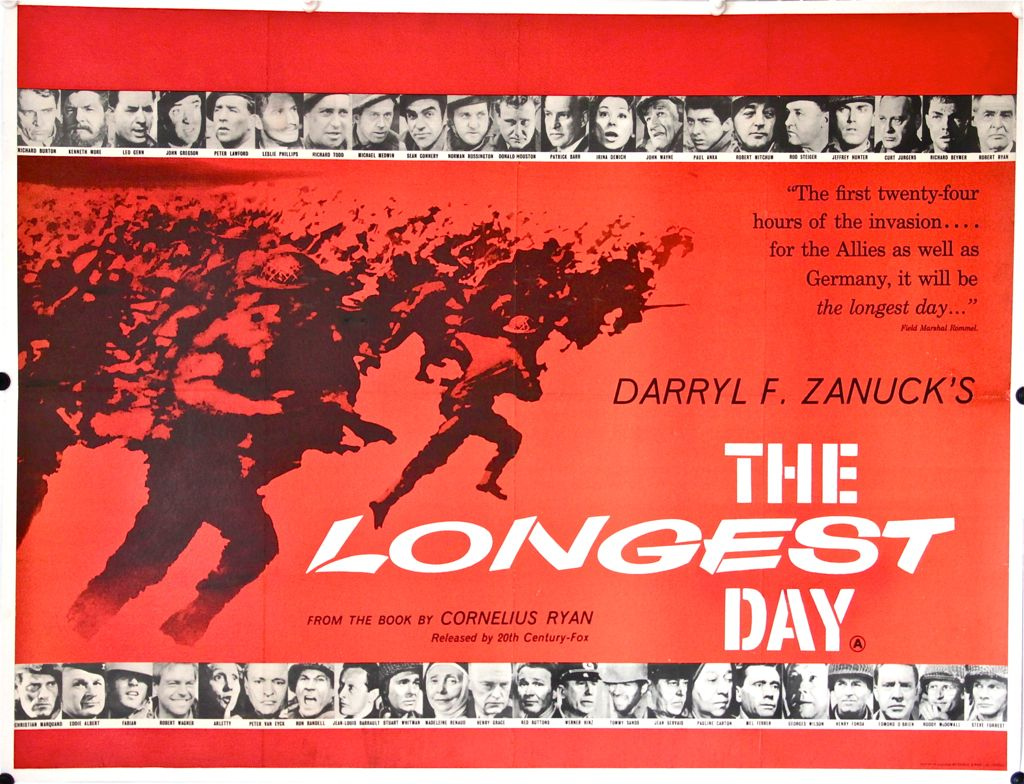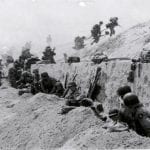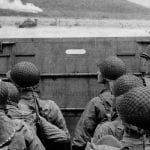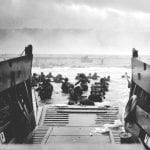The following article about D-Day movies is an excerpt from Barrett Tillman’ D-Day Encyclopedia. It is available for order now from Amazon and Barnes & Noble.
It is difficult to estimate the number of motion pictures in which D-Day is featured or bears on the plot. However, the following six are the most notable, in order of appearance.
D-Day, the Sixth of June (1956) directed by Henry Koster, starring
Among the oldest D-Day movies, this features Robert Taylor, Richard Todd, and Dana Wynter. American army officer Brad Parker (Taylor), with a wife back home, and British commando John Wynter (Todd) share affection for beautiful Valerie Russell (Wynter) in a poignant tale of unrequited romance. At the end of the film, nobody is happy—a realistic war story. The screenplay was based on Lionel Shapiro’s novel of the same title.
Best line: ‘‘I hope you enjoyed your steak. It’s horse.’’ Valerie Russell to Capt. Brad Parker.
The Longest Day (1962), directed by Ken Annakin and Gerd Oswald, et al. Adapted by Cornelius Ryan in collaboration with Romain Gary, James Jones, and others. The most iconic of all D-Day movies.
Starring John Wayne, Richard Burton, and a cast of thousands. Producer Darryl Zanuck’s sprawling epic set the bar for later historical movies, shot in black and white, with a gritty documentary style. Based on Cornelius Ryan’s best-seller, the story is told from nearly every perspective: those of the Allies, the French Resistance, and the German defenders. Despite innumerable technical errors, TLD received five Academy Award nominations (including for best picture, won by Lawrence of Arabia) and received Oscars for black-and-white cinematography and special effects.
Best line: ‘‘The thing that worries me about being one of The Few is how we keep on getting—fewer.’’ Richard Burton as Flying Officer David Campbell.
The Americanization of Emily (1964), directed by Arthur Hiller, screenplay by Paddy Chayefsky, based on the novel by William Bradford Huie, starring Julie Andrews and James Garner. Another black-and-white film, this dark comedy traces the evolution of a ‘‘hero,’’ ably portrayed with cynical charm by Garner as a cowardly U.S. Navy officer in pursuit of Andrews, a disarming British army chauffeur. Garner, as Lt. Cdr. Charlie Madison, is directed to photograph the first dead American on Omaha Beach—preferably a navy man. Emily received Oscar nominations for black-and-white cinematography and art direction.
Best line: ‘‘Appropriations are coming up in Congress and I want the first dead American on Omaha Beach to be a sailor.’’ Melvyn Douglas as Admiral William Jessup.

The Big Red One (1980), written and directed by Samuel Fuller, starring Lee Marvin and Mark Hamill. In counterpoint to The Longest Day’s macro approach, Big Red One takes the micro perspective of Fuller’s experience as a combat infantryman in World War II. His rifle squad of the Sixteenth Infantry Regiment, First Infantry Division, improbably remains intact from North Africa to VE-Day two and a half years later, but the vehicle allows an up-close view of men at war. The D-Day segment is extremely ‘‘tight,’’ with none of the sweeping vistas of The Longest Day.
Best line: ‘‘The U.S. Army is composed of the Big Red One and 12 million replacements.’’
Saving Private Ryan (1998), directed by Steven Spielberg, written by Robert Rodat, starring Tom Hanks and Matt Damon. A modern classic among D-Day movies. The first twenty minutes of SPR and the landing craft established a new level of combat realism in cinema. The film follows a patrol from the Second Ranger Battalion to find the sole survivor of four brothers and bring him to safety, evoking in the process the comradeship and terror of war. Spielberg’s masterful story telling received eleven Academy Award nominations (including best picture, won by Shakespeare in Love) and was honored with Oscars for direction, cinematography, editing, sound, and sound effects.
Best line: ‘‘This entire mission is a serious misallocation of valuable military resources. God gave me a special gift and made me a fine instrument of warfare and here I am on a rescue mission.’’ Barry Pepper as the sniper, Private Jackson.

Band of Brothers (2001), produced by Steven Spielberg and Tom Hanks. The most ambitious television production of all time, this HBO series is based on Stephen Ambrose’s study of Easy Company, 506th Parachute Infantry, 101st Airborne Division. It was filmed in ten installments covering the unit from training in 1942 through VE-Day in 1945. Each episode had different writers and directors, but the quality is uniformly superior throughout, with production values fully comparable to SPR. Though the focus is on Richard D. Winters’s career from lieutenant to major, the large cast features excellent actors who provide an unusually authentic look into small-unit cohesion. BoB is a superb treatment of men at war—heroes and heels, victors and survivors.
Best line: ‘‘We’re paratroopers; we’re supposed to be surrounded.’’ Damian Lewis as Capt. Richard Winters.
This article is part of our larger selection of posts about the Normandy Invasion. To learn more, click here for our comprehensive guide to D-Day.
 |
 |
 |
This article on D-Day movies is from the book D-Day Encyclopedia, © 2014 by Barrett Tillman. Please use this data for any reference citations. To order this book, please visit its online sales page at Amazon or Barnes & Noble.
You can also buy the book by clicking on the buttons to the left.
Cite This Article
"D-Day Movies: From ‘Longest Day’ to ‘Saving Private Ryan’" History on the Net© 2000-2024, Salem Media.
April 19, 2024 <https://www.historyonthenet.com/d-day-movies>
More Citation Information.










